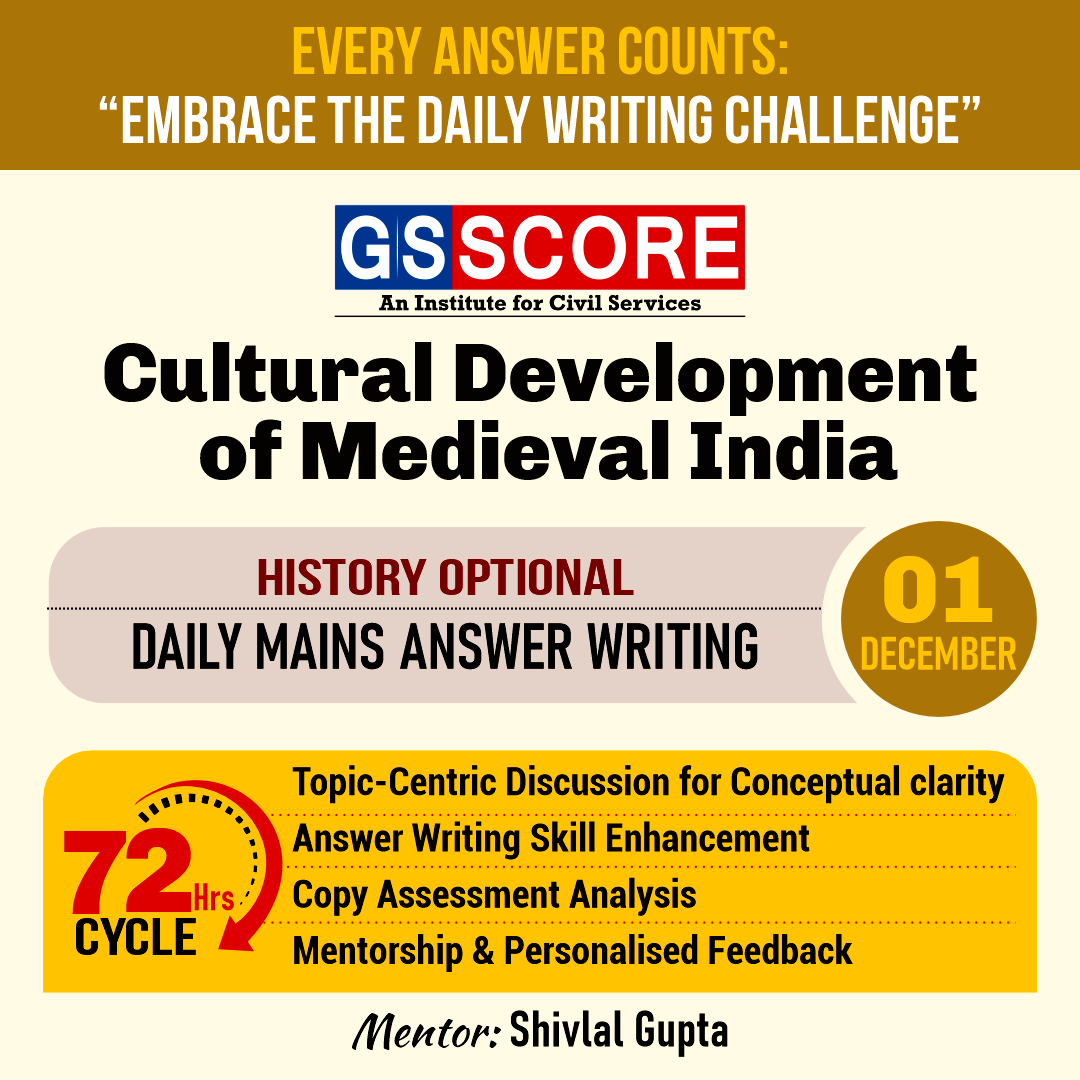


Instruction:
- There will be 2 questions carrying the First Question is-10 marks Write your answers in 150 words and the Second Question is-15 marks Write your answers in 250 words.
- Any page left blank in the answer-book must be crossed out clearly.
- Evaluated Copy will be re-uploaded on the same thread after 2 days of uploading the copy.
- Discussion of the question and one to one answer improvement session of evaluated copies will be conducted through Google Meet with concerned faculty. You will be informed via mail or SMS for the discussion.
Question #1. What factors have contributed for the growth of Bhakti Movement in South India? 10 marks (150 words)
Question #2. Given an account of the growth of regional languages and literature during the medieval period. 15 marks (250 words)
(Examiner will pay special attention to the candidate's grasp of his/her material, its relevance to the subject chosen, and to his/ her ability to think constructively and to present his/her ideas concisely, logically and effectively).
STEPS & INSTRUCTIONS for uploading the answers
Step 1 - The Question for the day is provided below these instructions. It will be available at 7:00 AM.
Step 2 - Uploading of Answers : Write the answer in A4 Sheet leaving proper margins for comments and feedback and upload the PDF in MY ACCOUNT section. Click on the option of SUBMIT COPY to upload the PDF.
Step 3 - Deadline for Uploading Answers: The students shall upload their answers by 7:00 PM in the evening same day. The first 50 copies will be evaluated.
Step 4 - Feedback : Mentors will give their feedback for the answers uploaded. For more personalised feedback, join our telegram channel by clicking on the link https://t.me/mains_answer_writing_cse . A one-to-one session will be conducted with the faculty after copy evaluation in 72 Hrs.
Model Answer
Question #1. What factors have contributed for the growth of Bhakti Movement in South India? 10 marks (150 words)
Approach:
- Briefly introduce the Bhakti Movement.
- Discuss the factors contributed for the growth of Bhakti Movement in South India.
- Conclusion
Hints:
The Bhakti movement was an important historical religious movement in medieval Hinduism that sought to bring religious reforms to all strata of society by adopting the method of devotion to achieve salvation.It was prominent in eighth-century south India (now Tamil Nadu and Kerala states), and spread northwards.
Factors contributed for the growth of Bhakti Movement in South India:
- The saiva Nayanar saints and vaisnava Alvar saints of South India spread the concept of bhakti among different sections of the society irrespective of caste and sex during the period between the 7th and the 10th century.
- They ignored rituals and traversed the region several times singing, dancing and advocating The Alvar and Nayanar saints used the Tamil language and not Sanskrit for preaching and composing devotional songs. Thus the movement could acquire a popular base.
- They won over many adherents of Buddhism and Jainism both of which by then became rigid and formal religions.
- These saint-poets simultaneously resisted the domination of the orthodox Brahmins by making bhakti accessible to all without any caste and sex discrimination.
The South Indian bhakti movement in its heyday succeeded in championing the cause of religious equality and consequently, the Brahmins had to accept the right of the low caste to preach, to have access to bhakti as a mode of worship and to have access even to the Vedas. Ultimately after the movement reached its zenith in the 10th century, it was gradually incorporated by the traditional Brahmanical religion.
Question #2. Given an account of the growth of regional languages and literature during the medieval period. 15 marks (250 words)
Hints
The medieval period saw tremendous growth and development in language and literature,both due to royal patronage of powerful rulers and the ongoing Bhakti and Sufi movements.
New languages like Urdu and Hindi came into existence, which were derivatives ofDehlavi. Amir Khusrau is known to have used this form first in his writings.
Bardic poets wrote books. PrithvirajRaso was written by Chand Bardai and Padmavat was written by Sufi poet Malik Muhammad Jayasi, who wrote it in the Hindustani language of Awadhi.
Bhakti saints of north India like Surdas, Tulsidas, Kabir, Mirabai, etc. used different dialects of Hindi in the forms of doha, chaupai, bhajan, etc.
Punjabi language was influenced by two trends—the Bhakti (Guru Nanak) and Sufi (Baba Farid). Guru Angad gave the script "Gurmukhi.
Sufi influences too were instrumental in the development of Persian-based languages, for example Urdu, Sindhi, etc.
Marathi was the result of Maharashtra dharma. It got encouragement by the writingsof saints like Tukaram, Namdev, Eknath, etc.
Telugu literature developed under the Vijayanagar rulers. Kannada was influenced byVeerashaivism and was later patronised by the Hoysalas.

